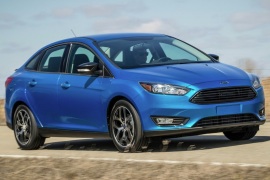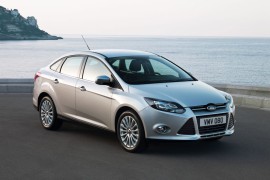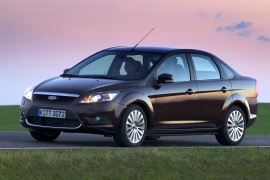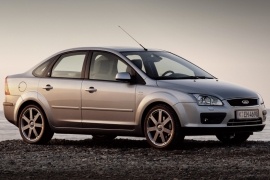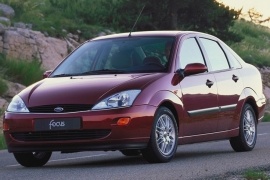FORD Focus Sedan Models/Series Timeline, Specifications & Photos
First production year: 1999
Engines: Gasoline, Diesel, Hybrid
The third generation of the Ford Focus was launched in 2012 and after just two years it received a facelift. It was the most sold vehicle nameplate in the world at that time.
The compact market was very competitive in 2014. After the whole world got out of recession and the economy was booming, the car sales went up through the roof. Ford understood that offering a wide choice of bodies will make the Focus a winner. The third generation of Focus was offered as a sedan as well as a hatchback or a station-wagon.
The sedan was one of the most important versions on the European market, where the three-box vehicles were considered more up-market than the hatchbacks, even though they had the same cost. On the facelifted version, the Focus Sedan featured narrower headlights and a new grille. The taillights were redesigned as well.
Inside, an option for an 8” touch-screen monitor on the center stack incorporated more buttons from the center stack. The standard version featured a 4.2” display. Regardless of the size of the screen, the Focus Sedan featured a standard back-up camera. The instrument cluster was similar to the non-facelifted version, but a recalibrated Electric power-steering enhanced the driving experience. In the back, there was room for three adults, but only two could have fit comfortably, and only if they were of average size.
Ford Focus sedan was offered with a wide choice of diesel and gasoline engines. It started with a 1.0-liter EcoBoost unit and went all the way up to a 2.0-liter EcoBoost. The 2.3-liter version was available only for the RS range, which was offered only as a 5-door hatchback.
FORD Focus Sedan 1.0L EcoBoost 5MT (100 HP)
FORD Focus Sedan 1.0L EcoBoost 5MT Start/Stop (100 HP)
FORD Focus Sedan 1.0L EcoBoost 6MT (125 HP)
FORD Focus Sedan 1.0L EcoBoost 6MT Start/Stop (125 HP)
FORD Focus Sedan 1.5L EcoBoost 6MT (150 HP)
FORD Focus Sedan 1.5L EcoBoost 6MT (182 HP)
FORD Focus Sedan 1.5L EcoBoost 6MT Start/Stop (150 HP)
FORD Focus Sedan 1.5L EcoBoost 6MT Start/Stop (182 HP)
FORD Focus Sedan 1.6L Ti-VCT 5MT (105 HP)
FORD Focus Sedan 1.6L Ti-VCT 5MT (125 HP)
FORD Focus Sedan 1.5L TDCi 6MT Start/Stop (120 HP)
FORD Focus Sedan 1.5L TDCi 6MT Start/Stop (95 HP)
FORD Focus Sedan 1.6L TDCi 6MT (115 HP)
FORD Focus Sedan 1.6L TDCi 6MT (95 HP)
FORD Focus Sedan 1.6L TDCi 6MT Start/Stop (115 HP)
FORD Focus Sedan 1.6L TDCi 6MT Start/Stop (95 HP)
FORD Focus Sedan 2.0L TDCi 6AT (150 HP)
Ford introduced the third generation of the Focus at the 2010 North American Motor Show in three body shapes, dropping the convertible version.
While the hatchback and the station wagon were addressed mainly to the young, or the young families with small children, the sedan was adequate for empty-nesters or car rental companies. Ford managed to create another decent example of a technologically advanced, reasonably priced compact vehicle.
The bodywork was more aerodynamic, and it had the new hexagonal face of the radiator grille. Its headlights were closer to those found in the Mondeo, adding more refinement to the known compact-sized vehicle. Even though it was a three-box sedan, its rear windscreen was very sloped, inducing the idea of a fastback shape. Its wide taillights crossed started from the sides of the car and continued over the trunk lid.
Inside, there was a new cockpit arrangement. The base model featured a 4" infotainment unit, but a larger, 8" touch-screen unit was available as an option. It featured Bluetooth connectivity and the SYNC connectivity package with voice control and navigation.
Ford offered the Focus sedan with a comprehensive engine choice ranged between 95 hp and 160 hp. Unlike the hatchback version, it wasn't available in the RS or ST version since Ford made it as a fuel-efficient family sedan or a money-maker for a fleet owner.
After four years on the market, Ford refreshed the second generation of the Focus and worked on the car's exterior and interior.
Ford introduced the second generation of the Focus in September 2004 at the Paris Motor Show. Fast forward to 2008 and, right at the beginning of the world financial crisis, it was refreshed. It was right as scheduled, and the timing couldn't be better.
Ford followed its kinetic design trend and introduced a new front fascia to the Focus. The bigger headlights swept back over the fenders, and the bigger lower grille in the bumper made the car looks better and more aggressive. Depending on the trim level, a chromed bar was mounted on the upper grille. In the back, the taillights resembled those installed on Focus's bigger brother, the Mondeo. For the upper trim level, the designers installed a chromed bar on the upper side of the license plate mounting point.
The interior was enhanced with the introduction of new features. For the Sony infotainment unit, there was new connectivity via Bluetooth and, for the navigation system, an SD-card based unit. In 2008, Ford introduced the keyless system plus a "Ford Power" push-button to start the car. A cap-less refill system was introduced to avoid fueling the car with the wrong fuel.
Under the hood, the engineers installed a new 2.0-liter turbodiesel unit that offered 110 hp. Depending on the engine choice, a 5- or 6-speed manual was fitted as standard. Selected models could have been ordered with the new PowerShift automatic (dual-clutch) transmission.
In 2004 Ford introduced the second generation of the Focus at the Paris Motor Show in three body shapes, but none of them was the sedan. That version was unveiled in 2005.
Ford had an interesting marketing strategy for the Focus. In March 2004 it showed the car at the Geneva Motor Show with black windows. In mid-2004, it revealed the sedan as a study at the Beijing Motor Show, and in September, it unveiled the production versions for the three and five doors versions and the station wagon. The production, four-door Focus, was revealed only in 2005.
From the outside, the headlights followed the triangular shape from the New-Edge-Design theme, but they were smaller. That left more room for the grille, which was broader and narrower. Thanks to its curved roofline and the small triangular window behind the rear doors, the Focus sedan showed an elegant look for the compact segment. In the rear, Ford installed Mondeo-like taillights on the quarter panels.
Inside, Ford offered the vehicle in a few trim levels, including the Ghia, as the top-luxury version. The most significant upgrade was the safety cell, which placed the Focus on top of its class in the EuroNCAP crash-tests results.
The sedan was expected for most of the fleet customers, who enjoyed the new engine lineup that offered fuel-efficient versions. Its power ranged between 80 hp and 146 hp with both turbo-diesel and gasoline options. An automatic transmission was available for selected versions.
After just two years on the market, Ford introduced a facelift for its compact-segment sedan, Focus.
Ford Focus was designed as a world car. The first generation was sold all over the world in a similar shape. The only differences were those related to different regulations on various continents. In 2001, the designers tried, and succeeded, to give the car a new line that kept it fresh.
The Focus was designed within the Edge-design trend, which combined long, arched lines into sharp angles. It was a love-it or hate-it car that changed the perspective of many buyers. A set of new headlights was installed, with lenses for the headlights that improved the night-driving visibility. The turn-signals were moved from bumpers inside the headlights. On the lower apron, a wider grille was installed to increase the cooling capacity. In the rear, the Focus Sedan received different lenses over the taillights with a clear design.
The interior kept the same unusual design that combined curved lines with sharp angles for the dashboard. Other than that, there was an improvement in the material's quality, an area where some customers had some complaints. Unfortunately, the hood kept the same key-only opening mechanism, which required the driver to stop the engine, move the blue oval from the grille aside, insert the key, turn left and right and then pop the hood.
Ford enlarged the engine option with the introduction of the 1.4-liter engine as the base version. For the diesel option, the Focus sedan received two new versions for the same 1.8-liter TDCI unit.
Ford Focus was a true, love-it or hate-it car, due to its controversial look and the new-edge styling promoted by American brand with other vehicles such as Puma or Cougar.
Introduced at the 1999 Geneva Motor Show, the Focus was replacing the Escort on the European market or Laser in other parts of the world. It was a new concept that brought the car into attention with its revolutionary design and engineering solutions. Moreover, apart from a convertible version, it covered all other body versions.
The triangular-shaped, with curved lines, emerged into sharp angles at the front, were part of the new-edge-design philosophy. A particular feature of the car, which many hated, was the behind-the-badge hood's unlocking mechanism. It couldn't be opened from inside the car like in any other vehicle. Designers installed the third row of windows behind the rear doors to diminish the blind spots and enhance the rear seat passengers' interior luminosity.
Inside, the new-edge-design language was continued on the dashboard. The upper lines of the instrument cluster emerged in sharp angles with the rest of the panel. Its rear seats offered good legroom and headroom. Due to the rear independent suspension, the trunk was not the biggest in its class, but that layout was needed to increase comfort.
Ford installed a wide choice of diesel and gasoline engines, which was paired as standard with a 5-speed manual gearbox. A 4-speed automatic was on the options list for specific engines. Due to its independent suspension in all corners, the Focus was a benchmark in its car-segment for the cornering speed.
